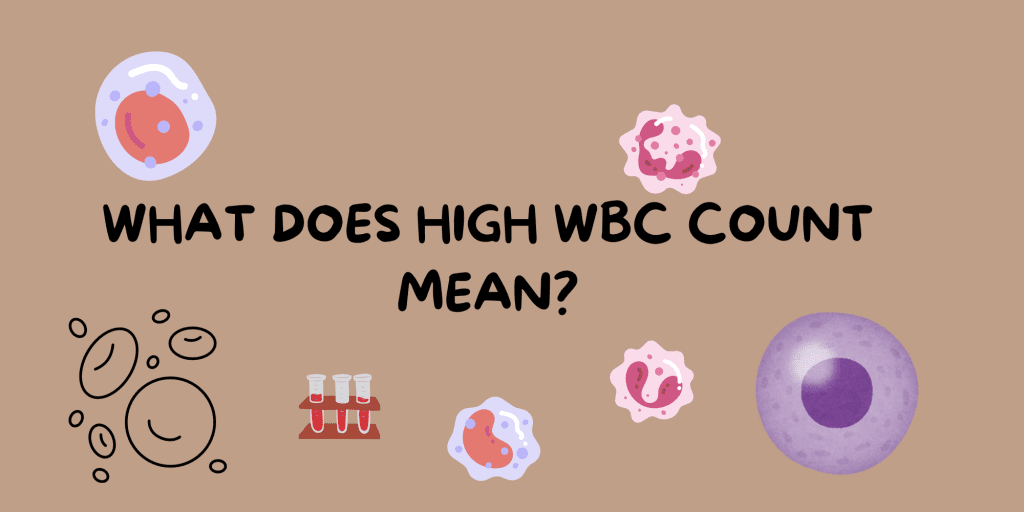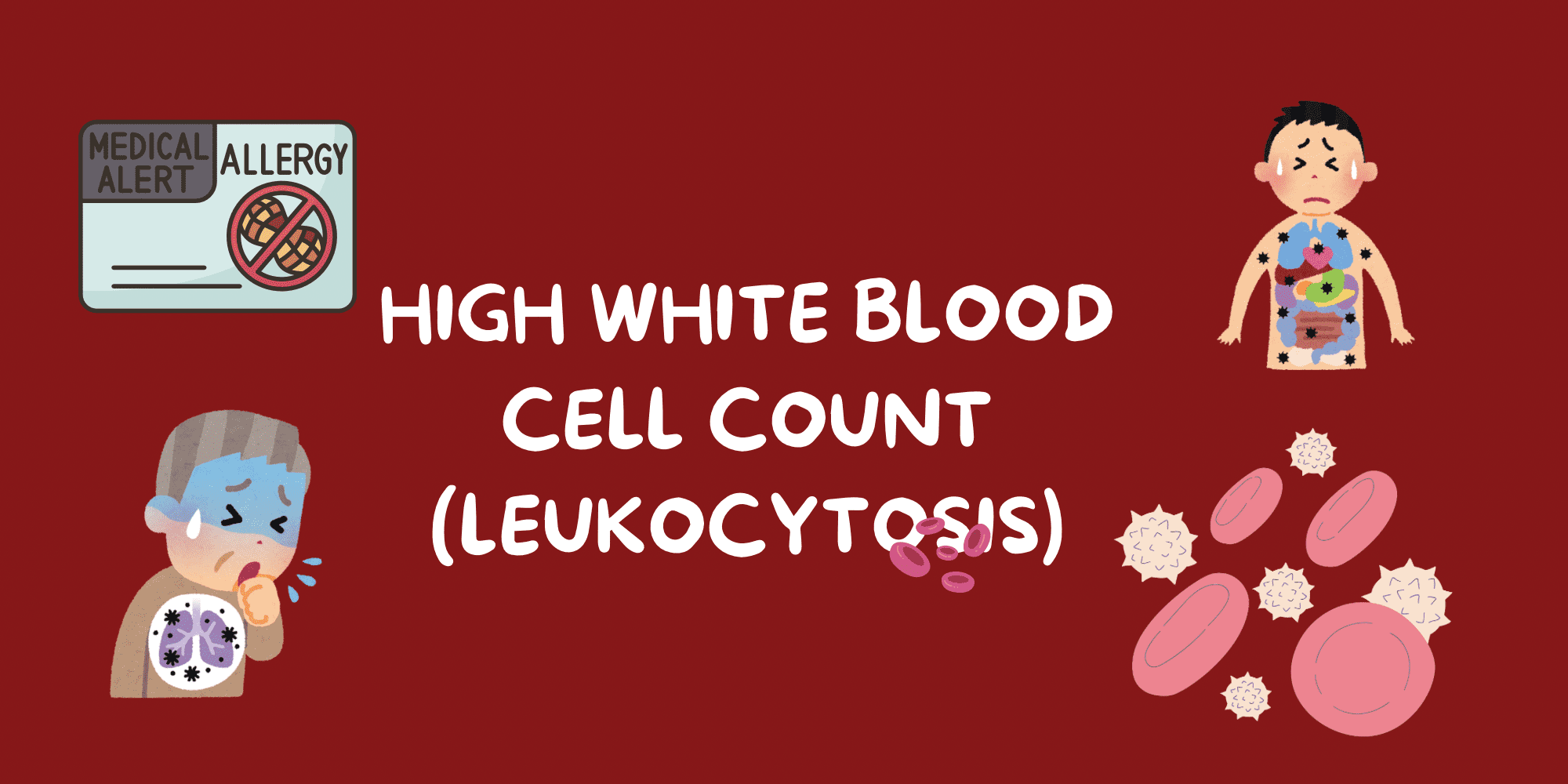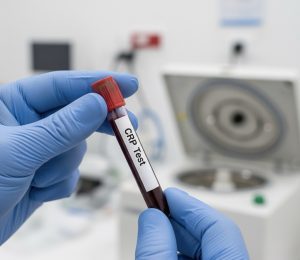Sometimes, a simple routine blood test can uncover a story your body has been quietly telling. Many people collect their results and find a note saying “elevated white blood cell count.” Immediately, worry sets in. Questions start flying: Is this an infection? Is it serious? What does high white blood cell count mean?
A high white blood cell count — or leukocytosis — doesn’t always mean danger, but it is a sign that your body is responding to something. White blood cells are the soldiers of the immune system, and when they increase beyond normal levels, it usually means the body is fighting an infection, inflammation, or reacting to certain stressors.
In this article, we’ll take a closer look at what exactly causes this rise, the different types of leukocytosis, and how each type gives unique clues about what’s happening in your body. By the end, you’ll understand how to interpret your results intelligently and know when to seek further medical attention.
WHAT IS LEUKOCYTOSIS?
Leukocytosis refers to an increase in white blood cells (WBCs) beyond the normal reference range. The typical normal WBC range in healthy adults is 4.0 to 10.0 ×10⁹/L.
When the total count rises above 11.0 ×10⁹/L, it’s considered high.
This condition can be temporary — such as after physical stress, emotional strain, or minor infection — or persistent, which might indicate something more serious, like an inflammatory disorder or bone marrow disease.
You may also want to read:
What Is ESR Test Used to Diagnose? Meaning, Normal Range, and Results Explained (2025 Guide)
TYPES OF LEUKOCYTOSIS
White blood cells aren’t a single type of cell; they’re a family of specialized defenders, each with a distinct job. When one type rises above its normal limit, the condition takes its name from that cell. Let’s go through them one by one:
#1. Neutrophilia
Neutrophils are the first responders whenever there’s an infection, especially bacterial. They rush to the site of injury or invasion to engulf and destroy pathogens.
The normal neutrophil range is 40–75% of total white blood cells, or roughly 2.0–7.5 ×10⁹/L.
When this number climbs above 7.5 ×10⁹/L, it’s called neutrophilia.
Neutrophilia is most often seen in bacterial infections such as pneumonia, appendicitis, or tonsillitis. It can also appear after surgery, burns, or stress, and sometimes as a side effect of medications like corticosteroids. Because neutrophils act quickly, a sudden increase usually signals an acute condition — something happening right now that your body is reacting to.
#2. Lymphocytosis
Lymphocytes are the white blood cells that coordinate the immune response and fight viral infections. They also help the body “remember” past invaders through antibody production.
The normal lymphocyte range is 20–45% or 1.0–4.5 ×10⁹/L.
When levels rise above 4.5 ×10⁹/L, we call it lymphocytosis.
This pattern often points toward viral illnesses such as hepatitis, rubella, or infectious mononucleosis. In some cases, it’s seen in chronic bacterial infections like tuberculosis, or in certain blood cancers such as chronic lymphocytic leukemia (CLL).
Lymphocytosis can persist longer than neutrophilia because many viral and chronic conditions take time to resolve.
#3. Monocytosis
Monocytes act as the cleanup crew. After an infection or inflammation, they digest damaged tissue and help the body heal.
Their normal range is 2–10% or 0.2–1.0 ×10⁹/L.
Values above 1.0 ×10⁹/L indicate monocytosis.
Monocytosis is usually a sign of chronic inflammation or prolonged infection. It may occur in tuberculosis, endocarditis, inflammatory bowel disease, or during the recovery phase after acute infections. Because monocytes mature into macrophages — long-lived immune cells — their increase often points to processes that have been ongoing rather than new infections.
#4. Eosinophilia
Eosinophils are the body’s defense against parasites and also play a major role in allergic reactions.
Their normal range is 1–6% or 0.04–0.4 ×10⁹/L.
A count above 0.4 ×10⁹/L is considered eosinophilia.
In countries like Nigeria and across Africa, eosinophilia is common because of worm infestations such as ascariasis, hookworm, or schistosomiasis. It also appears in asthma, eczema, and drug allergies. When eosinophil levels are high, it’s a clear sign the body is either reacting to allergens or battling parasites.
#5. Basophilia
Basophils are the rarest type of white blood cell, normally less than 1% or 0.01–0.1 ×10⁹/L. They contain granules filled with histamine and heparin — chemicals involved in allergic and inflammatory responses.
When counts exceed 0.1 ×10⁹/L, it’s termed basophilia.
Basophilia is uncommon, but when it occurs, it may be linked to allergic reactions, chronic inflammation, or bone marrow disorders like chronic myeloid leukemia (CML). Because it’s rare, doctors often order further investigations when it appears to confirm the underlying cause.
#6. Mixed or General Leukocytosis
Sometimes, all white blood cell types rise slightly together. This can happen during acute stress, severe infections, or autoimmune conditions where multiple immune pathways are active at once.
When the report simply says “elevated total WBC count” without specifying which cells are high, additional tests like a differential count help determine the exact pattern.
What Does High White Blood Cell Count Mean?

When you look at your lab result and see an elevated total white cell count, you naturally wonder, “what does high white blood cell count mean?” The answer depends on why the rise occurred.
In simple terms, it means your immune system is actively responding to something — whether that’s an infection, inflammation, allergy, or even stress. The white blood cell count acts like a mirror reflecting the activity inside your body. But what makes interpretation tricky is that several unrelated conditions can raise it.
A temporary increase might mean your body is fighting off a mild infection or recovering from an injury. A persistent or extremely high count, however, could suggest an underlying chronic illness, an inflammatory condition, or rarely, a disorder of the bone marrow.
In clinical practice, understanding what does high white blood cell count mean involves more than just reading the number — it means correlating it with symptoms, medical history, and sometimes, further tests like a differential count or peripheral blood smear.
What Causes High White Blood Cell Count?
When your white blood cell count rises, it’s not just a single number going up — it’s often a particular type of white blood cell responding to a trigger. To really understand what does high white blood cell count mean, you have to look at which type is high and why:
#1. Neutrophilia (High Neutrophils)
When you see high neutrophils, what does high white blood cell count mean is often a bacterial infection. Think of appendicitis, pneumonia, tonsillitis, or abscesses.
Other causes include:
- Inflammation: burns, tissue necrosis, or heart attack.
- Stress reactions: after surgery, trauma, or vigorous exercise.
- Corticosteroid use: certain medications increase WBCs by reducing their adherence to vessel walls.
- Myeloproliferative disorders: such as chronic myeloid leukemia (CML).
So, if your result shows neutrophilia, your body may be fighting a bacterial or inflammatory process.
#2. Lymphocytosis (High Lymphocytes)
Lymphocytes handle long-term defense, particularly against viruses.
When you see this pattern, what does high white blood cell count mean could be a viral infection such as hepatitis, mumps, or infectious mononucleosis.
Other causes include:
- Chronic infections: tuberculosis or syphilis.
- Autoimmune diseases: like rheumatoid arthritis.
- Cancers of the lymphoid tissue: chronic lymphocytic leukemia (CLL).
- Post-vaccination responses or stress recovery periods.
This type of leukocytosis reflects immune system memory and viral engagement.
#3. Monocytosis (High Monocytes)
If your lab report shows monocytosis, it is likely linked to chronic infections such as tuberculosis, endocarditis, or malaria.
It may also appear in:
- Recovery phase of acute infections (as the body heals).
- Autoimmune diseases: lupus, ulcerative colitis.
- Certain blood cancers: monocytic leukemia or myelodysplastic syndromes.
Persistent monocytosis often signals long-standing immune activity.
#4. Eosinophilia (High Eosinophils)
Eosinophils are the “allergy cells” — they increase during allergic reactions and parasitic infections.
Here, what does high white blood cell count mean may be connected to:
- Parasitic infestations: such as malaria, filariasis, or schistosomiasis.
- Allergic conditions: asthma, eczema, or allergic rhinitis.
- Certain skin diseases: dermatitis or drug reactions.
- Autoimmune disorders: Churg–Strauss syndrome.
For Nigerians, parasitic causes are quite common, especially in tropical environments with high infection exposure.
#5. Basophilia (High Basophils)
If elevated, what does high white blood cell count mean may involve:
- Allergic reactions: drug allergies or food hypersensitivity.
- Chronic inflammation: ulcerative colitis or hypothyroidism.
- Myeloproliferative diseases: chronic myeloid leukemia.
Although rare, basophilia often appears alongside other abnormalities in serious bone marrow disorders.
#6. Mixed Leukocytosis
Sometimes more than one type is high — for instance, neutrophilia with lymphocytosis may appear during certain infections or after steroid therapy.
In these cases, interpretation depends on clinical history, other lab findings, and physical symptoms.
So, when trying to interpret what does high white blood cell count mean, it’s crucial to check which cell line is driving the increase.
How Is White Blood Cell Count Diagnosed?
Detecting and interpreting a high white blood cell count involves more than one laboratory technique. As a medical laboratory scientist, you know results differ based on method precision and equipment used. To fully answer what does high white blood cell count mean, let’s break down the major diagnostic approaches:
#1. Complete Blood Count (CBC or FBC)
This is the most common test done using automated hematology analyzers like Sysmex, Mindray, or Beckman Coulter.
- A small blood sample (usually 2 mL) is collected into an EDTA anticoagulant tube.
- The analyzer counts the total WBCs electronically using impedance or flow cytometry principles.
- It also provides the differential count — showing the percentage of each WBC type.
This automated method is fast, accurate, and routinely used in hospitals and diagnostic laboratories across Nigeria.
2. Differential White Blood Cell Count
This test goes a step deeper to determine which specific cell type is elevated.
Differentials can be:
- Automated (machine differential): done by analyzers using scatter plots and fluorescence.
- Manual (microscopic differential): where a stained blood smear is examined under a microscope, and 100 cells are manually classified into neutrophils, lymphocytes, monocytes, eosinophils, and basophils.
Manual methods are especially useful for confirming abnormal patterns seen by automation, such as blast cells in leukemia.
#3. Peripheral Blood Film Examination
A drop of blood is spread on a glass slide, air-dried, and stained with Leishman or Wright stain.
Under the microscope, a trained laboratory scientist examines:
- WBC morphology (size, shape, granulation)
- Presence of immature or abnormal forms Distribution of different WBCs
This test is vital for identifying qualitative abnormalities that machines can’t interpret, especially when trying to understand what does high white blood cell count mean in complex diseases like leukemia or bone marrow failure.
#4. White Blood Cell Count by Hemocytometer (Manual Counting)
Before automation became standard, WBC counts were manually done using a Neubauer chamber.
The process involves:
- Diluting the blood with a white cell diluting fluid (like Turk’s solution).
- Loading the chamber and counting WBCs under a microscope at ×10 magnification.
Although less common today, this method is still valuable in low-resource settings where automation isn’t available.
#5. Bone Marrow Examination
When white blood cell abnormalities persist or are extreme, a bone marrow aspiration or biopsy is done.
This reveals whether the cause lies in bone marrow overproduction (as in leukemia) or reactive proliferation (as in infections).
It’s the definitive test for determining why the WBC count is high — and therefore essential in diagnosing what does high white blood cell count mean when routine tests are inconclusive.
#6. Flow Cytometry and Immunophenotyping
Used mainly in specialized labs, this method classifies white cells based on surface markers.
It’s especially important for diagnosing leukemias and lymphomas, where abnormal white cell clones are identified.
Management and Treatment of High White Blood Cell Count
The treatment depends entirely on the underlying cause. There’s no single drug that “brings down” white blood cells because they’re a symptom, not a disease.
- If due to infection: antibiotics, antivirals, or antiparasitic medications are prescribed.
- If caused by inflammation: anti-inflammatory or immunosuppressive therapy may be needed.
- If related to cancer: chemotherapy or targeted therapies control the bone marrow’s overproduction.
- If physiological: no treatment is required — the count usually normalizes naturally once the trigger ends.
In mild cases, lifestyle measures such as adequate hydration, rest, and stress control can help the count return to normal.
So when you wonder how to reduce WBC count, the key is not to chase the number itself but to treat the cause behind it.
Prevention of High White Blood Cell Count
You can’t always prevent leukocytosis, but you can minimize avoidable causes.
- Maintain good hygiene to prevent infections.
- Eat balanced meals rich in fruits, vegetables, and antioxidants.
- Avoid smoking.
- Manage stress with rest, exercise, or meditation.
- Keep chronic conditions like diabetes and hypertension under control.
These healthy habits not only stabilize your immune system but also reduce unnecessary fluctuations that lead people to ask, “what does high white blood cell count mean for me again?”
High White Blood Cell Count During Pregnancy
During pregnancy, the body undergoes several natural changes, including an increase in blood volume and white cell production.
It’s normal for WBC counts to rise slightly, especially in the third trimester and during labour.
This physiological leukocytosis helps the body prepare for delivery and prevents infection during childbirth.
Doctors don’t usually worry unless the count is very high or accompanied by fever or other symptoms.
So in pregnancy, what does high white blood cell count mean? Often, it simply reflects a normal adaptation — not an infection.
What Does It Mean When White Blood Cell Count Is High in Urine?
A high white blood cell count in urine (called pyuria) is different from high WBC in the blood.
It usually points to an infection in the urinary tract, kidneys, or bladder.
Women are more prone to this due to shorter urethras, and it often presents with symptoms like frequent urination, burning sensation, or lower abdominal pain.
Urine WBCs are detected through a urinalysis, not a blood test.
In this case, what does high white blood cell count mean refers specifically to urinary infection, not systemic leukocytosis
Can Stress or Exercise Cause High White Blood Cell Count?
Yes. Both emotional stress and intense physical activity can temporarily elevate WBC levels.
The body releases stress hormones like adrenaline and cortisol, which mobilize white blood cells into the bloodstream.
This is a physiological response, not a disease — once the stress or activity ends, the count drops back to normal.
So next time you ask, “what does high white blood cell count mean” after a hectic day or workout, remember: it might simply be your body reacting to stress.
When Should You Worry About a High White Blood Cell Count?
You should seek medical attention if:
- The WBC count remains high on repeated tests
- It’s accompanied by fever, weight loss, or fatigue
- You notice unusual bruising or persistent infections
These could be signs of underlying conditions that need attention.
Knowing what does high white blood cell count mean helps you avoid panic when results are mild, but also recognize when further testing is crucial.
Can dehydration cause a high white blood cell count?
Yes. When you’re dehydrated, your blood volume decreases, which can make white blood cells appear more concentrated. Once you rehydrate, your WBC count usually returns to normal. Persistent elevation, however, should still be checked by a doctor.
Can antibiotics lower white blood cell count?
Some antibiotics can temporarily lower white blood cell counts, especially in people taking strong or long-term treatments. Always tell your doctor about any recent medications if your WBC count drops unexpectedly.
What foods can help balance white blood cell levels naturally?
A balanced diet rich in fruits (like oranges and pawpaw), leafy greens, garlic, ginger, and omega-3-rich fish supports a healthy immune system. However, food alone can’t treat leukocytosis — always address the underlying cause.
CONCLUSION
So, what does high white blood cell count mean after all?
It’s your body’s way of saying something is happening — an infection, inflammation, allergy, or even a normal reaction to stress or pregnancy.
By understanding which white cell type is elevated, and correlating it with symptoms, healthcare professionals can uncover the real cause and guide proper treatment.
Whether your WBC is slightly raised or significantly high, the most important step is interpretation — not assumption.
A well-done blood test doesn’t just show numbers; it reveals the story of your immune system in action.




